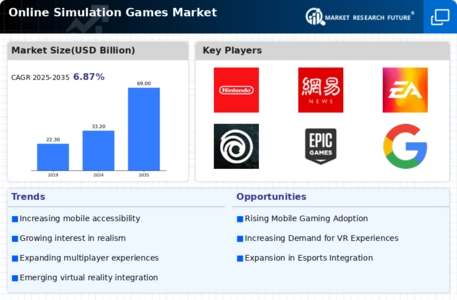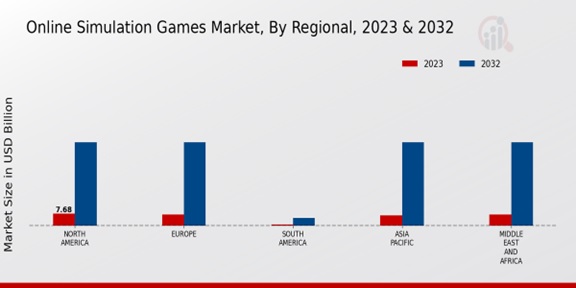Market Growth Projections
The Global Online Simulation Games Market Industry is projected to experience substantial growth over the coming years. With a market value of 33.2 USD Billion in 2024, it is anticipated to reach 69.0 USD Billion by 2035, reflecting a robust expansion trajectory. The compound annual growth rate (CAGR) of 6.87% from 2025 to 2035 indicates a sustained interest in simulation games across various platforms. This growth is likely driven by technological advancements, increased investment in game development, and the rising popularity of e-sports. The market's future appears promising, with numerous opportunities for innovation and engagement.
Technological Advancements
Technological innovations play a pivotal role in shaping the Global Online Simulation Games Market Industry. The integration of virtual reality (VR) and augmented reality (AR) technologies enhances user experiences, creating more immersive environments. As these technologies become more accessible and affordable, developers are increasingly incorporating them into simulation games. This evolution not only attracts a broader audience but also encourages existing players to engage more deeply with the content. The anticipated growth of the market, projected to reach 69.0 USD Billion by 2035, underscores the significance of these advancements in driving user engagement and satisfaction.
Diverse User Base and Accessibility
The Global Online Simulation Games Market Industry is characterized by its diverse user base, which spans various age groups and interests. This inclusivity is facilitated by the accessibility of online platforms, allowing users from different backgrounds to engage with simulation games. The availability of free-to-play models and mobile gaming options further broadens the audience, making these games more appealing to casual gamers. As the market evolves, developers are increasingly focusing on creating content that resonates with this diverse demographic, ensuring that simulation games remain relevant and engaging for all users.
Rising Popularity of Simulation Games
The Global Online Simulation Games Market Industry experiences a notable surge in popularity, driven by the increasing engagement of diverse demographics. As of 2024, the market is valued at approximately 33.2 USD Billion, reflecting a growing interest among players of all ages. This trend is particularly evident in educational and training simulations, which are gaining traction in both academic and corporate settings. The immersive nature of these games fosters learning and skill development, making them appealing to institutions and individuals alike. The expansion of internet accessibility further enhances this trend, allowing more users to participate in online simulation experiences.
Growing E-Sports and Competitive Gaming
The rise of e-sports and competitive gaming significantly influences the Global Online Simulation Games Market Industry. Many simulation games are now incorporating competitive elements, allowing players to engage in tournaments and leagues. This trend attracts a dedicated player base and fosters community engagement, as players seek to improve their skills and compete against others. The increasing visibility of e-sports events, coupled with sponsorships and media coverage, further legitimizes simulation games as a competitive platform. As the market continues to evolve, the integration of competitive features is likely to enhance player retention and attract new users.
Increased Investment in Game Development
The Global Online Simulation Games Market Industry benefits from heightened investment in game development, which fuels innovation and diversity in offerings. Major gaming companies and independent developers alike are allocating substantial resources to create unique simulation experiences. This influx of capital enables the development of high-quality graphics, intricate gameplay mechanics, and engaging narratives. As a result, the market is expected to grow at a compound annual growth rate (CAGR) of 6.87% from 2025 to 2035. This investment trend not only enhances the quality of simulation games but also expands the variety available to consumers, catering to different preferences and interests.














